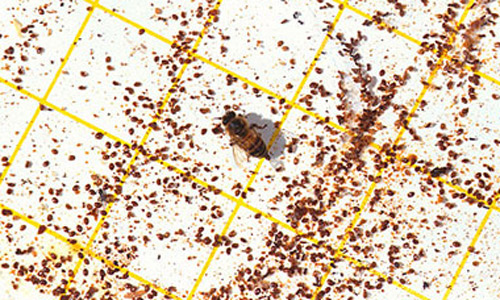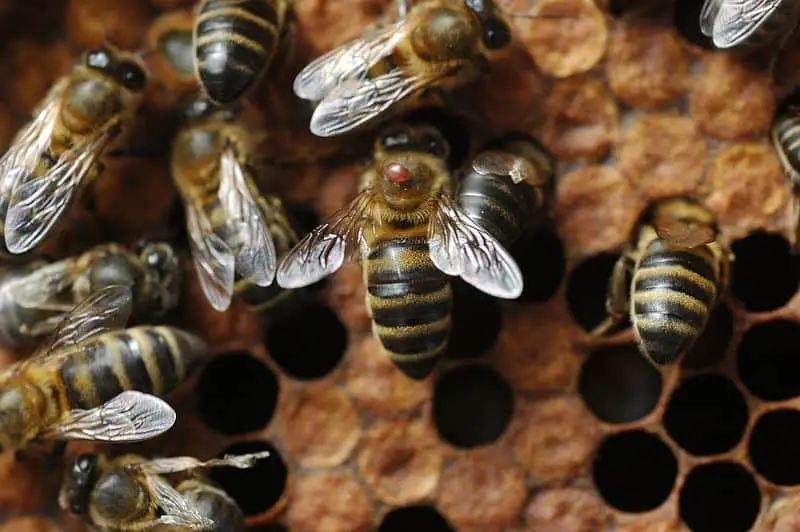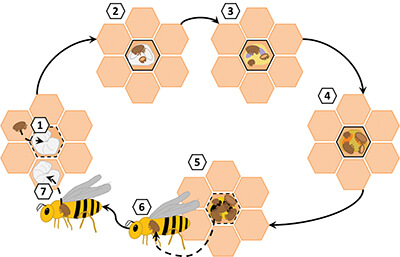Females lay their eggs in uncapped brood cells and the young feed on developing bees. The Honeybee Act of 1922 was enacted primarily to prevent importing infested bees into the US.

Varroa Mite Management Options For Honey Bees Bee Keeping Varroa Mite Mites
One of the honey bees worst enemies is a tiny mite called Varroa destructor.

Varroa mite facts. Varroa prefers young bees to older workers probably because of the lower titer of the Nasonov gland pheromone geraniol which strongly repels the mite. Destructor are the most serious pest of honey bees worldwide. First beekeepers often aid weak colonies by adding bees or brood from a healthier colony and this practice helps spreads the mite.
The parasite has now spread to almost all parts of the world except for Australia and is a serious threat to bee health. Varroa mite on a bee The female mite is also known for moving between bees. It then crawls into and takes up residence in the beeswax cells containing young bee larvae brood cell before they are sealed.
The life span of infected bees is significantly shortened. Varroa jacobsoni mite 326 - Widespread distribution. Varroa destructor usually takes some time before being noticed within a colony sometimes up.
University and government scientists beekeepers and other bee experts attribute this years possible higher bee losses to an increased presence of the Varro. For more information. The Varroa destructor mite is the most destructive enemy of the Western honey bee Apis mellifera.
When in an actively reproducing bee colony the mite disembarks and seeks brood cells containing third-stage bee. The Varroa mite is only able to reproduce on honey bee brood while only adult female Varroa mites are able to feed on adult honey bees. Fact sheet for HONEY BEE tracheal MITE with some comparisons to Varroa Mite FACTS-13 ACARAPIS WOODI causes acarine disease of the honey bee APIS MELLIFERA.
Second beekeepers may transport colonies from one area to another facilitating the spread of Varroa regionally. Varroa mites Varroa jacobsoni and V. Adult female reddish-brown to dark brown flattened oval crab-like up to 18 mm long 2 mm wide on the thorax or in abdominal folds.
Normally only on Asian honeybees where it is not a serious pest. The Varroa Mite Varroa Destructor is a tiny parasitic mite just 1-16mm which enters the hive on adult bees. The mites are tiny reddish brown external parasites of honey bees.
In 1987 the mites were first diagnosed in Ohio. Males yellowish with lightly tanned legs and spherical bodies about 1 mm diameter. In fact there is speculation that the viruses not the mites are the cause of most damage to the bees.
It is small and yet highly dangerous. In fact since Varroa mites were discovered in the United States studies show that managed beehives in the state of North Carolina have fallen by at least 44. Third individual colonies may swarm moving to a new location and spreading Varroa simultaneously.
Since 1950 the mite has been found on Apis mellifera in Europe Africa and South America. The varroa mite is almost exclusively found as a parasite on honeybees. Varroa mites are parasitic mites which require a honey bee host to survive and reproduce.
The Varroa mite can reproduce only in a honey bee colony. The species is a vector for at least five debilitating bee viruses. The mite pierces the soft intersegmental tissues of the bees abdomen or behind the bees head and feeds on the hemolymph.
Female mites even travel to different. An inspection of a hives brood cells is thus the most reliable means of detection. Varroa was originally confined to tropical Asia.
How is it characterised. European and North American honeybee colonies were found to be the main transmission hubs which is to be expected since they are key areas in the global bee trade. However mite eggs are soon laid in worker brood cells.
The mites will inherit the Earth. Varroa also may pass between colonies in other ways. Varroa destructor Varroa mite is an external parasitic mite that attacks and feeds on the honey bees Apis cerana and Apis melliferaThe disease caused by the mites is called varroosis.
Nymphal stages of the mite feed on immature bees. Female mites also parasitize adult bees hiding in between the insects first abdominal segments. The Varroa mite just happened to be particularly effective at spreading the virus.
Therefore the entire life cycle of Varroa mite occurs within the honey bee colony. Recently found on European bees Papua New Guinea. Preference is for drone cells.
When you look at how Varroa mites take over bee colonies its easier to see just how and why theyre so devastating to bee populations everywhere. South American infestations were thought to be a result of imported queens. Varroa destructor Anderson and Truman previously described as Varroa jacobsoni Oud is a parasitic mite of adult bees and brood.
In the life cycle female mites lay up to 12 eggs in a bee brood cell. This is what every beekeeper needs to know about Varroa mites. After the mites mature.
On their own individual mites are easily identifiable to the naked eye. The only other known host is another species of APIS A. The Varroa mite Varroa jacobsoni is an external parasite of honey bees that attacks adult bees and their developing brood.
Varroa mites can also spread viruses further affecting the health of colonies. As she is a vector for various viruses this can spread disease within the colony. The current pandemic started in the mid-20th century and its spread mirrors that of the Varroa mite.
It attaches to the body of the bee and weakens the bee by sucking fat bodies.

Varroa Mite Varroa Destructor Anderson And Trueman

Apivox Varroa Eliminator Project

How To Get Rid Of Varroa Mites Naturally Beehour Com

Varroa Management Using Drone Brood Removal Bob Kloss Northwest New Jersey Beekeepers Association May 14 Ppt Download

Varroa Mite Life Cycle And Reproduction Usda Ars

Information About Varroa Destructor And Honey Bees 2016 Eco Bee Box Modern Urban Beekeeping

A New Way Of Protecting Bees Against Varroa Mites Bee Care Bee Facts Bee Varroa Mite

Varroa Destructor Feeds Primarily On Honey Bee Fat Body Tissue And Not Hemolymph Pnas
Bbc The Honeybee And The Varroa Mite

Honey Bee And Varroa Mites Animation How Varroa Destructor Devastates Honey Bee Colonies Youtube

Managing Varroa Mites In Honey Bee Colonies Bee Facts Honey Bee Life Cycle Bee Colony

The More The Merrier How Reproduction Affects Pyrethroid Resistance In Varroa American Bee Journal

Varroa Mite Reproductive Biology Extension Bienen

How To Control A Varroa Mite Problem Apicultura Abejas Los Acaros
Facts On Varroa Destructor Mites Waikato Domestic Beekeepers Association





